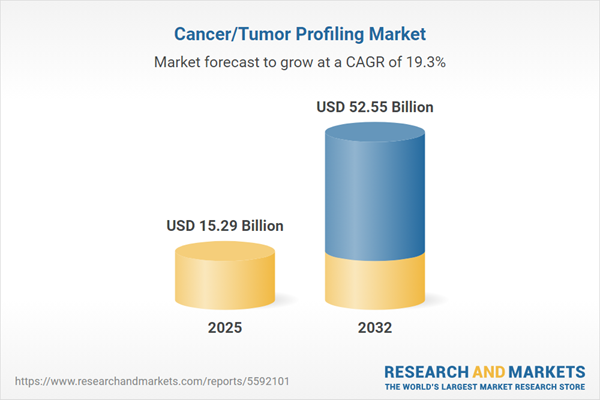Speak directly to the analyst to clarify any post sales queries you may have.
The tumor profiling market is rapidly redefining cancer diagnostics and personalized medicine, as healthcare providers and industry leaders leverage advanced molecular technologies to achieve more targeted patient care and streamlined clinical workflows.
Market Snapshot: Tumor Profiling Market Growth and Outlook
The Cancer/Tumor Profiling Market grew from USD 12.77 billion in 2024 to USD 15.29 billion in 2025 and is forecast to advance at a CAGR of 19.34%, reaching USD 52.55 billion by 2032.
This trajectory highlights the industry’s strong performance as precision oncology and molecular diagnostics become standard across global healthcare settings.Scope & Segmentation: Comprehensive Coverage Across Technologies and End Users
- Technology – Conventional PCR, Digital PCR, FISH (including Chromosome Enumeration Probes, Copy Number Variation, and Fusion Gene Detection), IHC (Direct, Indirect, and Tissue Microarray), Microarray (Comparative Genomic Hybridization, Expression Profiling, SNP Genotyping), Next Generation Sequencing (Targeted Sequencing: Amplicon Based and Hybrid Capture, Transcriptome Sequencing, Whole Exome and Whole Genome Sequencing), Real Time PCR (Dye Based, Probe Based).
- Product Type – Consumables and Reagents (Antibodies, PCR Reagents, Probes, Sequencing Reagents), Instruments (Fluorescence Microscopes, Mass Spectrometers, Microarray Scanners, PCR Instruments, Sequencers), Software & Services (Bioinformatics Software, Cloud Platforms, Consultation Services, Data Management Systems).
- Application – Breast Cancer (Gene Expression Profiling, Genetic Mutation Detection, Proteomic Profiling, Receptor Profiling), Colorectal Cancer (Epigenetic Profiling, MSI Testing, Mutation Analysis), Lung Cancer (Minimal Residual Disease Monitoring, Molecular Susceptibility Testing, Therapy Selection), Prostate Cancer (Copy Number Variation Analysis, Fusion Detection, Gene Expression Analysis).
- End User – Diagnostic Laboratories (Clinical and Reference Laboratories), Hospitals & Clinics (Oncology Departments and Pathology Labs), Pharma & Biopharma Companies (Clinical Trial Units, Companion Diagnostic Services, Drug Development Divisions), Research & Academic Institutes (Biotech Research Centers, Government Research Institutes, University Research Labs).
- Regions and Countries – Americas (North America: United States, Canada, Mexico; Latin America: Brazil, Argentina, Chile, Colombia, Peru), Europe, Middle East & Africa (Europe: United Kingdom, Germany, France, Russia, Italy, Spain, Netherlands, Sweden, Poland, Switzerland; Middle East: United Arab Emirates, Saudi Arabia, Qatar, Turkey, Israel; Africa: South Africa, Nigeria, Egypt, Kenya), Asia-Pacific (China, India, Japan, Australia, South Korea, Indonesia, Thailand, Malaysia, Singapore, Taiwan).
Tumor Profiling Market: Key Takeaways for Decision-Makers
- Integration of advanced molecular analysis technologies is enabling precise cancer diagnostics and supporting the shift toward personalized treatment strategies across clinical and research environments.
- Bioinformatics, streamlined sample preparation, and end-to-end solutions are driving faster diagnostic turnaround and stronger confidence among clinicians and laboratory professionals.
- Collaborations between diagnostic developers and biopharmaceutical companies are accelerating the approval and adoption of companion diagnostics, enhancing therapy alignment with molecular findings.
- Strategic alliances promoting local manufacturing and flexible sourcing are mitigating supply chain risks, particularly in response to evolving trade and tariff scenarios.
- The interplay of regulatory changes and reimbursement models is shaping how new tumor profiling products are evaluated, adopted, and scaled within diverse healthcare systems.
- Regional variation in technology adoption and regulatory environments requires tailored approaches to maximize penetration and effectiveness in each market.
Tariff Impact: Navigating 2025 US Tariff Changes
New United States tariff measures implemented in 2025 are directly impacting import costs, supply chain choices, and strategic sourcing for tumor profiling solutions. Providers are responding by renegotiating vendor contracts, localizing manufacturing, and exploring joint ventures to reduce dependencies. These adaptations are strengthening supply resilience and supporting the ongoing flow of molecular diagnostics despite fluctuating geopolitical conditions.
Methodology & Data Sources
Report findings are based on a combination of in-depth primary interviews with industry stakeholders, secondary analysis of peer-reviewed literature, patent filings, company disclosures, and regulatory filings. Rigorous triangulation and validated modeling ensure accuracy and consistency across technology segments, product types, applications, and regional markets.
Why This Report Matters
- Enables informed investment, sourcing, and product development decisions by presenting actionable intelligence across all market segments and regional opportunities.
- Supports strategy formulation by clarifying disruptive technology trends, regulatory landscape changes, and profile-specific clinical applications.
- Equips senior leaders with evidence-driven guidance to align commercial priorities with the evolving needs of global oncology care.
Conclusion
Tumor profiling’s evolution is redefining oncology diagnostics, blending technology, regulation, and partnership to create new opportunities in patient care. Success hinges on agility, cross-sector collaboration, and a commitment to scalable, validated innovation.
Additional Product Information:
- Purchase of this report includes 1 year online access with quarterly updates.
- This report can be updated on request. Please contact our Customer Experience team using the Ask a Question widget on our website.
Table of Contents
3. Executive Summary
4. Market Overview
7. Cumulative Impact of Artificial Intelligence 2025
Companies Mentioned
The companies profiled in this Cancer/Tumor Profiling market report include:- Thermo Fisher Scientific Inc.
- Illumina, Inc.
- F. Hoffmann-La Roche Ltd
- QIAGEN N.V.
- Agilent Technologies, Inc.
- Bio-Rad Laboratories, Inc.
- PerkinElmer, Inc.
- Guardant Health, Inc.
- Natera, Inc.
- NeoGenomics, Inc.
Table Information
| Report Attribute | Details |
|---|---|
| No. of Pages | 199 |
| Published | October 2025 |
| Forecast Period | 2025 - 2032 |
| Estimated Market Value ( USD | $ 15.29 Billion |
| Forecasted Market Value ( USD | $ 52.55 Billion |
| Compound Annual Growth Rate | 19.3% |
| Regions Covered | Global |
| No. of Companies Mentioned | 11 |









